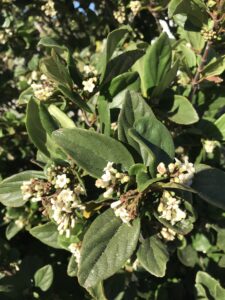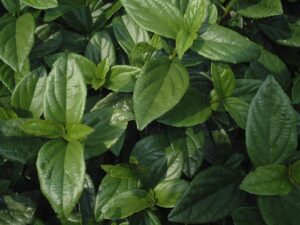S & J Nursery’s Guide to Growing
Viburnum Suspensum
/ Sandankwa Viburnum
For Northeast Florida Gardens
Viburnum Suspensum Origins:
– Viburnum Suspensum is not Native to North America, it was originally found growing in Japan and does extremely well in Florida’s landscapes. Classified as a Florida Friendly plant!
Sandankwa Viburnum Preferred Exposure:
– Sandankwa Viburnum will tolerate full sun to shade situations in the Northeast Florida | Jacksonville | St. Augustine areas gardens.
Viburnum Suspensum Foliage:
– Large evergreen foliage makes Viburnum Suspensum a showy landscape accent any time of the year. Its large leaves are a deep glossy dark green color and have an almost leathery look and feel to them.
Viburnum Suspensum Soil Preference / Salt tolerance:
– Viburnum Suspensum will prefer well drained soils to moist soils and is
not particular about the makeup or content of that soil. It tolerates clay, sand, loam acidic or alkaline conditions equally well.
– Viburnum Suspensum or Sandankwa Viburnum has good salt tolerance and is ideal for coastal landscapes.
 Sandankwa Viburnum Size Variance:
Sandankwa Viburnum Size Variance:
– Viburnum Suspensum grows 6-12 ft high and 4-8 ft wide in the North Florida | Jacksonville | St. Augustine landscape.
Viburnum Suspensum Growth Habit:
– Viburnum shrubs will need clipped and shaped to keep it as a squared hedge for privacy screens and foundation planting, but when lower branches are removed and it is allowed to grow as a tree a nice round head will develop without our help.
– Viburnum Suspensum has lush foliage that remains dense and full to the
ground and makes it an ideal shrub for gardens and landscapes in our area.
Viburnum Suspensum Growth Rate:
– Moderate growing shrub will establish itself into the landscape fairly quickly growing up to 6 inches in a growing season with proper water and fertilizer.
Viburnum Suspensum Bloom:
– Fragrant, clusters of attractive white flowers have a tinge of pink to them
and cover the plant each spring followed by small red berries that mature to a deep black.
Viburnum Suspensum Water Requirements:
– Viburnum Suspensum is known to tolerate wet soils and can be used in areas where moisture would be more problematic for other shrubs.
Best Uses For Sandankwa Viburnum:
– Viburnum Suspensum is an ideal hedge for both foundation plantings around the home and hedge screens for privacy. Its glossy green foliage makes it attractive year round.
Care of S & J Nursery’s North Florida | Jacksonville | St. Augustine
Shrubs:
– Shrubs can be planted in the North Florida | Jacksonville | St.Augustine area at any time during the year. In normal and well draining soils dig the hole as deep as the root ball and two to three times as wide. Plant the top of the root ball level or slightly higher than the surrounding soils. When
planting in poorly drained soils make sure to plant your shrubs a minimum of 3 inches ABOVE the surrounding soil level.
– Water every day during the establishment period. For most 3 gallon size shrubs in the North Florida landscape in average soil, that is neither heavy clay that holds water or really sandy that will take 2-3 weeks of daily watering to ensure that your newly planted shrub will begin to put out new roots and grow into its new home happily. After the first few weeks begin tapering back your watering to every other day then every third day and so on until your newly planted items are flourishing without your assistance.
– If planting larger shrubs you may need to extend the initial care a bit longer to protect your investment and get your shrubs off to the best start possible.
– IMPORTANT: If planting shrubs in heavy clay soils that hold allot of water after a rain or irrigating, remember to check the soil for moisture by sticking your fingers into the soil near the root ball of the newly planted shrub down to 2-3 inches. If it remains wet from the previous watering wait for heat top 2-3 inches to dry out before watering again.
– IMPORTANT: When planting shrubs into poor sandy soils be sure to amend the planting hole by mixing compost or cow manure etc. with the native soil that will go back in the hole around the new plants root ball when installing your shrub material, this will not only give your new shrubs good soil to grow its new roots into but help it hold water.
– When planting shrubs from containers be sure to loosen the roots as much as possible pulling loose roots away from the root ball before installing your new plants, if the roots are to tight to easily loosen with your hands use a knife to cut a few slits into the root ball being careful to go all the way from the top to the bottom and making the cut at least an inch deep. This will ensure that your plant will immediately begin to form new roots into its new surrounding soil.
– Mulch newly planted shrubs whenever possible.
– Fertilize each spring with a mixture of Milorganite and a slow release poly coated plant food such as Osmocote or Stay Green general purpose plant food, sprinkling the fertilizer around the mulch circle underneath the foliage of the tree.
– Prune as needed to shape each spring and or summer.

